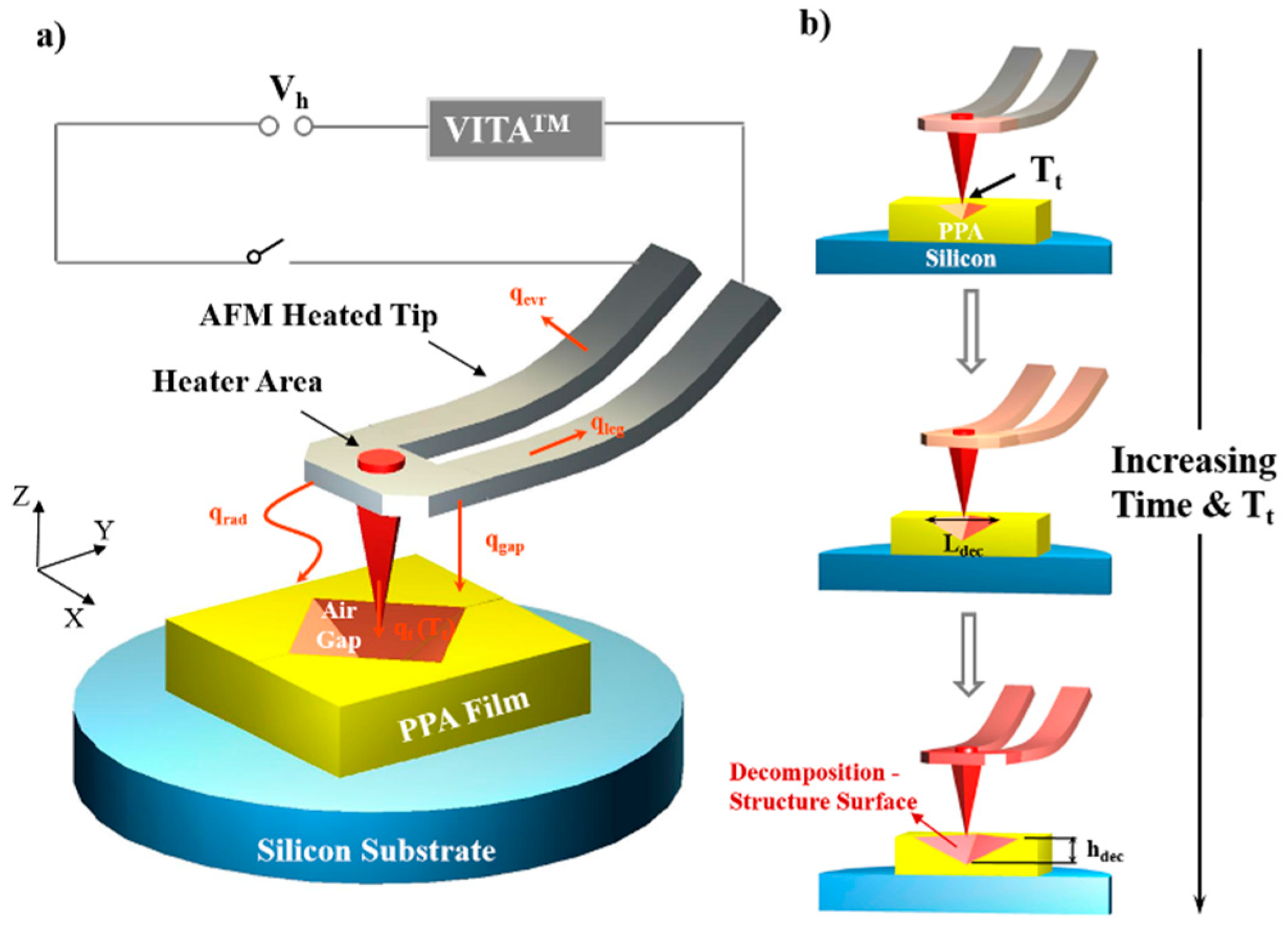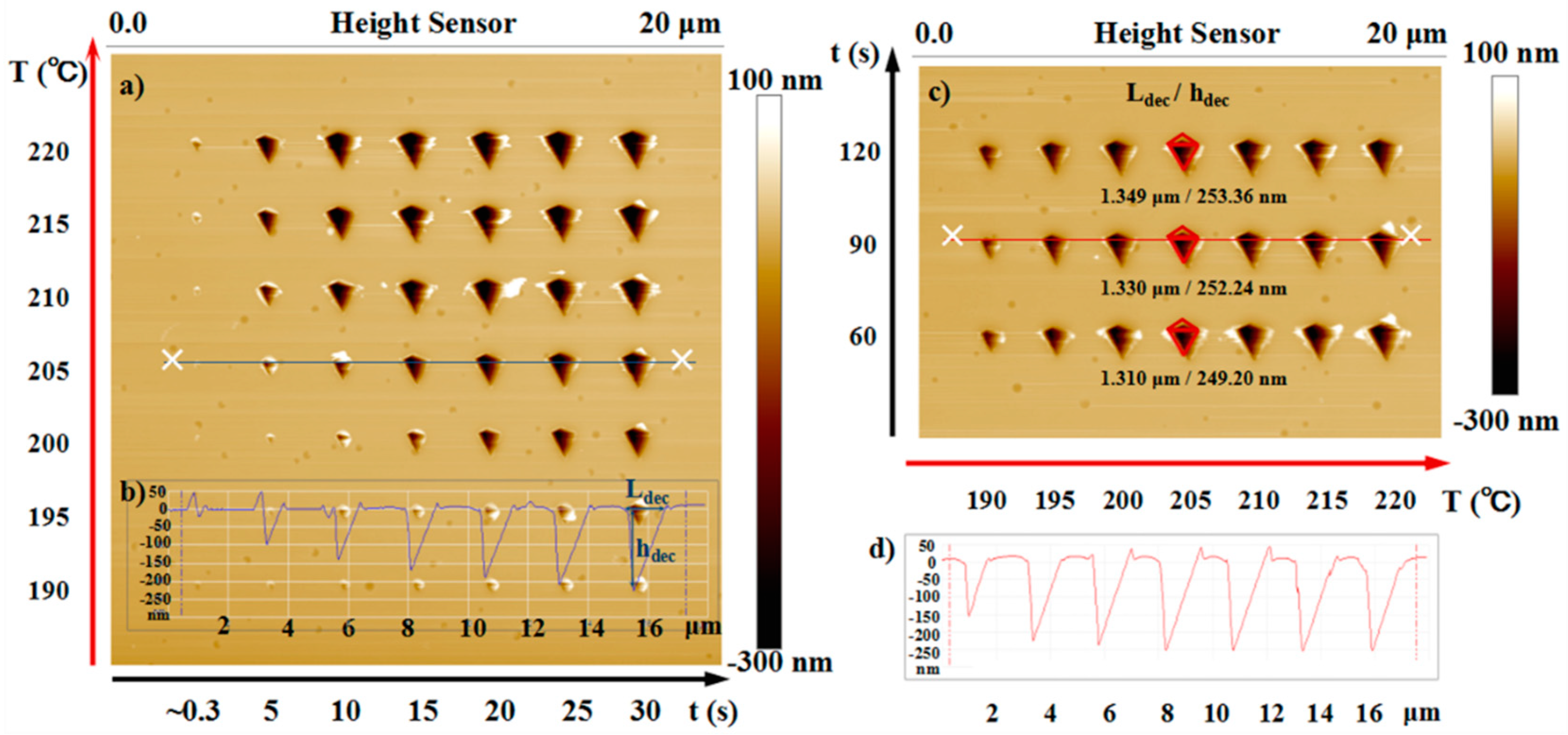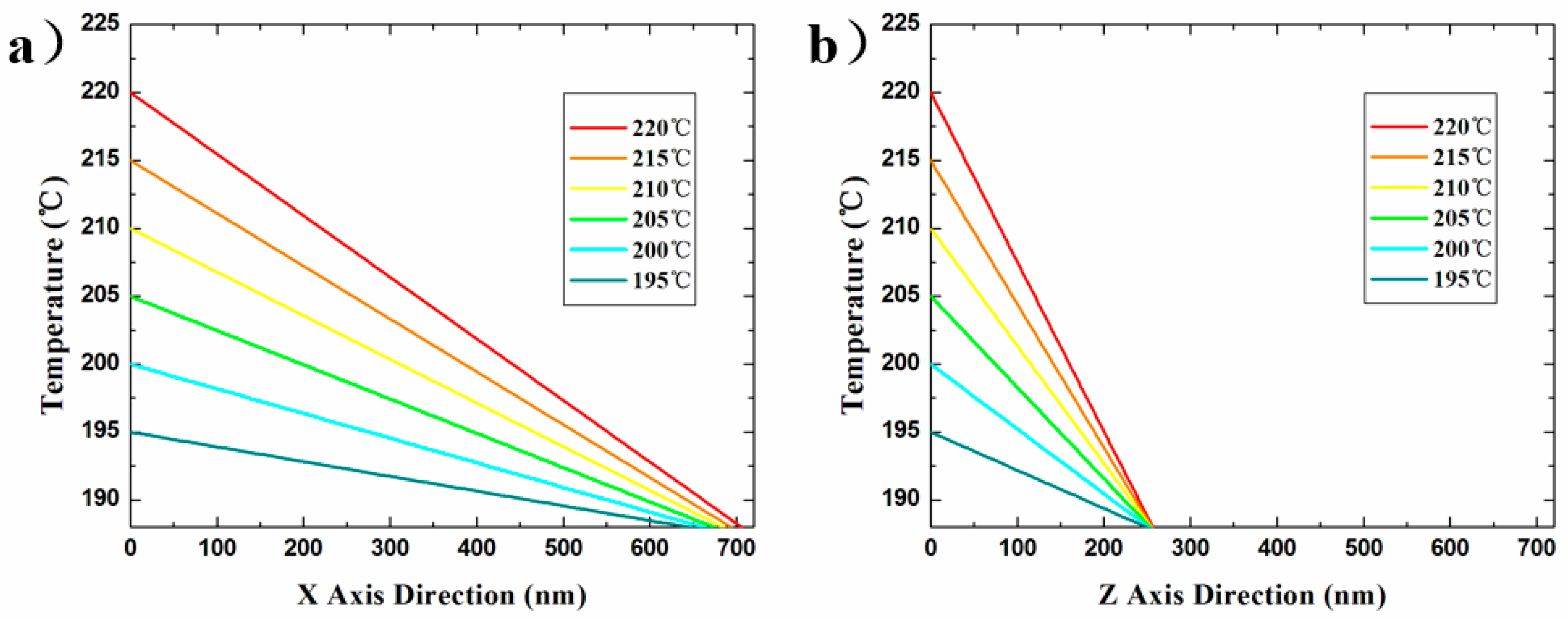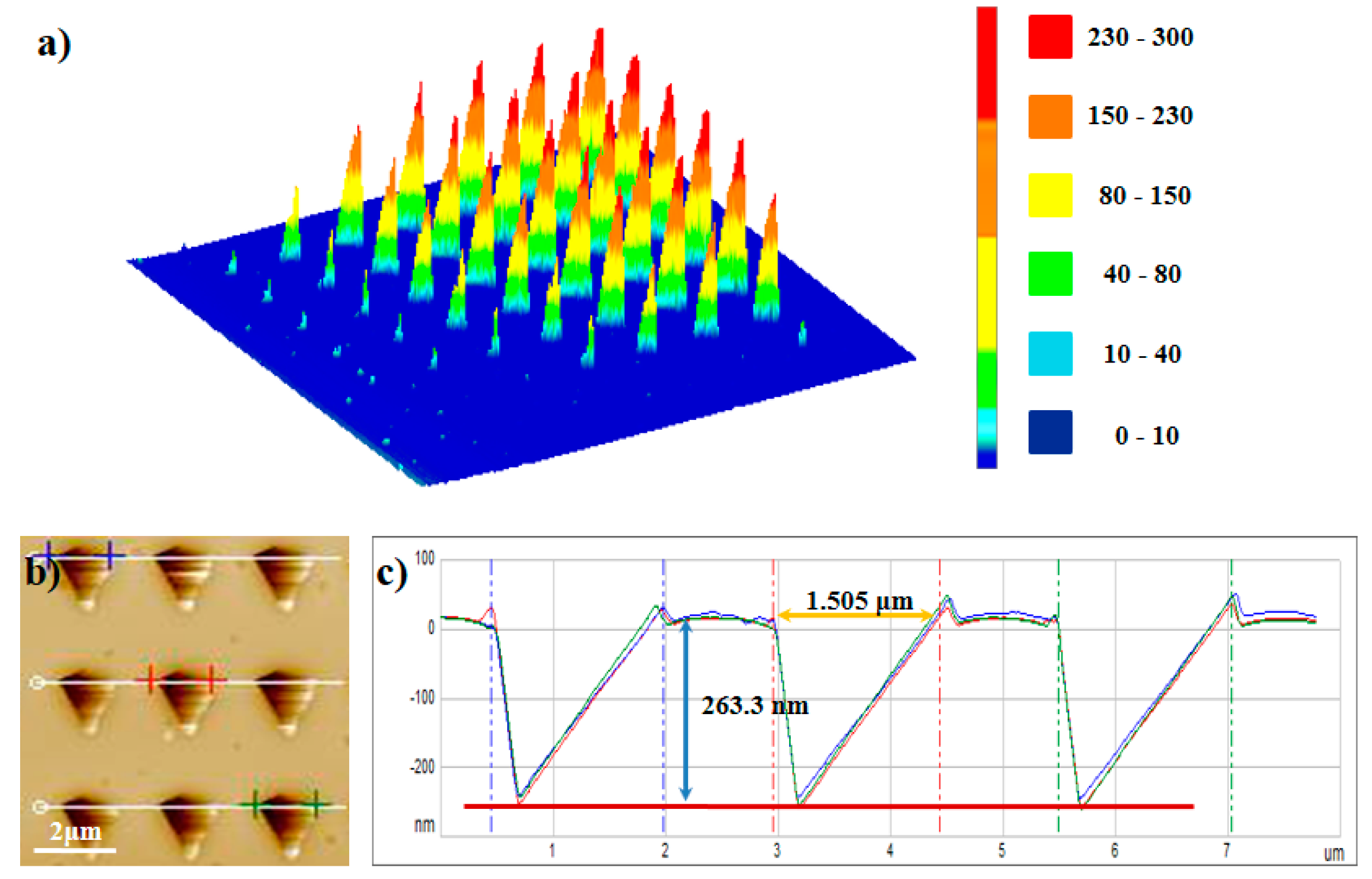Nano/Microscale Thermal Field Distribution: Conducting Thermal Decomposition of Pyrolytic-Type Polymer by Heated AFM Probes
Abstract
1. Introduction
2. Materials and Methods
2.1. Polyphthalaldehyde (PPA) Films
2.2. Atomic Force Microscopy
2.3. Thermal Expansion Measurements
2.4. Heat-Induced decomposition
3. Results and Discussion
3.1. Heat Induced Localized PPA Decomposition
3.2. Simplified Steady State 3D Model
- (1)
- Contact heat transfer: contact heat transfer at the tip–sample interface causes surface decomposition of the PPA material and produces a nano-scale air gap.
- (2)
- Thermal radiation: when the tip–sample distance is in the nanoscale at the beginning of the formation of the air gap, there is a very remarkable phenomenon of thermal radiation. However, the exact effective dimension of the thermal radiation range is hard to determine.
- (3)
- Convection heat transfer: nanomaterial PPA decomposition is accompanied by solid–gas phase transition. When the air gap structure expands, there will be a convective heat transfer layer on the surface of the material, the thickness of which is related to the decomposition speed.
- (4)
- The latent heat of phase transition: the solid–gas phase transition on the surface of the PPA material is always in existence. However, it has not been carried out under equal pressure in the gradually expanding micro-nano-scale air gap. Therefore, the latent heat of phase change is difficult to calculate by the time derivative of the volume change of the material.
- (5)
- Air gap medium heat transfer: in all of the heat transfer processes described in 2), 3), and 4), there has always existed a heat conduction of the heated tip to the PPA surface through the sub-continuous air medium, whereas the thermal conductivity of the air medium due to the nanoscale effect is most likely anisotropic in the air gap space, early in the heating time. Moreover, the heat transfer through air is shown to be dependent on the sample thermal conductivity [41].
- (1)
- The system is in a steady-state;
- (2)
- The very small part near the spherical tip peak with a pyramidal geometry shape and a preset temperature T1 can be regard as the heat source of air gap heat transfer;
- (3)
- The latent heat of cooling on the convective surface can be neglected [33]; and
- (4)
- Phase changes can be neglected.
4. Conclusions
- (i)
- Different nano/microscale pyramid air gaps with an approximately rhombic surface contour were formed on the surface of the PPA film by the thermal effect of the heated tip with its location holding at the initial contact point and temperature ranging from 190 to 220 °C for the various heating durations (0–120 s). The air gap horizontal and vertical dimensions ranged from 235 ± 13.8 to 1412 ± 19.6 nm and 6.6 ± 2.0 to 256.5 ± 1.5 nm, respectively.
- (ii)
- The heat transfer in the horizontal and vertical directions was estimated from the variable air gap dimensions. In the air gap between the heated tip and sample surface, the horizontal was greater when compared with the vertical heat transport, and the horizontal thermal transfer was not always symmetric and the deviation appeared on the further side from the cantilever fixed end, which was determined by the air gap heat transfer mode, tip geometry shape, and the cantilever mounting angle. The position of the 188 °C isothermal surface of the steady-state temperature field in air gaps was quantitatively determined by our experimental method. The maximum space range of the air gap temperature field in our investigation was horizontal at ~700 nm and vertical at ~250 nm.
- (iii)
- A simplified model of the 3D steady-state thermal field for the nano/microscale air gap was established and the boundary condition was obtained by measuring the feature sizes of the air gap structures. The temperature distribution could be calculated by the model, and the results showed that the higher the preset tip temperature, the steeper the temperature gradient close to the tip peak. By using our simplified model, the temperature distribution could be quantitatively calculated with only the measurements of the air gap feature sizes without measuring the tip geometry shape, the cantilever mounting angle, and the system (heatable tip, medium, and sample material) heat conduction characteristics, which is a useful simplification for the investigation of complex heat transfer problems in the nano/microscale air gap.
- (iv)
- Based on the calculation of our model, we fabricated programmable nano/microscale (20–1500 nm) pyramid structures on the PPA film. The structure dimensions were designed by controlling the temperature field around the heated tip. The processed structures had great consistency and repeatability, thus may be a potential application of nanofabrication based on SThM.
Author Contributions
Funding
Conflicts of Interest
References
- King, W.P.; Bhatia, B.; Felts, J.R.; Kim, H.J.; Kwon, B.; Lee, B.; Somnath, S.; Rosenberger, M. Heated Atomic Force Microscope Cantilevers And Their Applications. Annu. Rev. Heat Transf. 2013, 16, 287–326. [Google Scholar] [CrossRef]
- Garcia, R.; Knoll, A.W.; Riedo, E. Advanced scanning probe lithography. Nat. Nanotechnol. 2014, 9, 577–587. [Google Scholar] [CrossRef] [PubMed]
- Pires, D.; Hedrick, J.L.; De Silva, A.; Frommer, J.; Gotsmann, B.; Wolf, H.; Despont, M.; Duerig, U.; Knoll, A.W. Nanoscale Three-Dimensional Patterning of Molecular Resists by Scanning Probes. Science 2010, 328, 732–735. [Google Scholar] [CrossRef] [PubMed]
- Holzner, F.; Paul, P.; Despont, M.; Cheong, L.L.; Hedrick, J.; Duerig, U.; Knoll, A.W. Thermal probe nanolithography: In-situ inspection, high-speed, high-resolution, 3D. Proc. SPIE 2013. [Google Scholar] [CrossRef]
- Wei, Z.; Wang, D.; Kim, S.; Hu, Y.; Yakes, M.K.; Laracuente, A.R.; Dai, Z.; Marder, S.R.; Berger, C.; King, W.P.; et al. Nanoscale Tunable Reduction of Graphene Oxide for Graphene Electronics. Science 2010, 328, 1373–1376. [Google Scholar] [CrossRef] [PubMed]
- Raghuraman, S.; Elinski, M.B.; Batteas, J.; Felts, J.R. Driving Surface Chemistry at the Nanometer Scale Using Localized Heat and Stress. Nano Lett. 2017, 17, 2111–2117. [Google Scholar] [CrossRef] [PubMed]
- Wang, D.; Kodali, V.; Ii, W.D.U.; Jarvholm, J.E.; Okada, T.; Jones, S.C.; Rumi, M.; Dai, Z.; King, W.P.; Marder, S.R.; et al. Thermochemical Nanolithography of Multifunctional Nanotemplates for Assembling Nano-Objects. Adv. Funct. Mater. 2009, 19, 3696–3702. [Google Scholar] [CrossRef]
- Ding, F.; Stöferle, T.; Mai, L.; Knoll, A.W.; Mahrt, R. Vertical microcavities with high Q and strong lateral mode confinement. Phys. Rev. B 2013, 87. [Google Scholar] [CrossRef]
- Park, K.; Cross, G.; Zhang, Z.M.; King, W.P. Experimental Investigation on the Heat Transfer between a Heated Microcantilever and a Substrate. J. Heat Transf. 2008, 130, 102401. [Google Scholar] [CrossRef]
- Kim, K.; Park, K.; Lee, J.; Zhang, Z.; King, W.P. Nanotopographical imaging using a heated atomic force microscope cantilever probe. Sens. Actuators A Phys. 2007, 136, 95–103. [Google Scholar] [CrossRef]
- Jeong, W.; Hur, S.; Meyhofer, E.; Reddy, P. Scanning Probe Microscopy for Thermal Transport Measurements. Nanoscale Microscale Thermophys. Eng. 2015, 19, 279–302. [Google Scholar] [CrossRef]
- Shi, L.; Dames, C.; Lukes, J.R.; Reddy, P.; Duda, J.; Cahill, D.G.; Lee, J.; Marconnet, A.; Goodson, K.E.; Bahk, J.-H.; et al. Evaluating Broader Impacts of Nanoscale Thermal Transport Research. Nanoscale Microscale Thermophys. Eng. 2015, 19, 127–165. [Google Scholar] [CrossRef]
- Assy, A.; Lefèvre, S.; Chapuis, P.-O.; Gomes, S. Analysis of heat transfer in the water meniscus at the tip-sample contact in scanning thermal microscopy. J. Phys. D: Appl. Phys. 2014, 47, 442001. [Google Scholar] [CrossRef]
- Menges, F.; Riel, H.; Stemmer, A.; Gotsmann, B. Quantitative Thermometry of Nanoscale Hot Spots. Nano Lett. 2012, 12, 596–601. [Google Scholar] [CrossRef]
- Kim, K.; Chung, J.; Hwang, G.; Kwon, O.; Lee, J.S. Quantitative Measurement with Scanning Thermal Microscope by Preventing the Distortion Due to the Heat Transfer through the Air. ACS Nano 2011, 5, 8700–8709. [Google Scholar] [CrossRef]
- Sadat, S.; Tan, A.; Chua, Y.J.; Reddy, P. Nanoscale Thermometry Using Point Contact Thermocouples. Nano Lett. 2010, 10, 2613–2617. [Google Scholar] [CrossRef]
- Nelson, B.; King, W.P. Temperature calibration of heated silicon atomic force microscope cantilevers. Sens. Actuators A Phys. 2007, 140, 51–59. [Google Scholar] [CrossRef]
- Ge, Y.; Zhang, Y.; Booth, J.; Weaver, J.M.R.; Dobson, P. Quantification of probe–sample interactions of a scanning thermal microscope using a nanofabricated calibration sample having programmable size. Nanotechnology 2016, 27, 325503. [Google Scholar] [CrossRef]
- Ge, Y.; Zhang, Y.; Weaver, J.M.R.; Dobson, P. Dimension- and shape-dependent thermal transport in nano-patterned thin films investigated by scanning thermal microscopy. Nanotechnology 2017, 28, 485706. [Google Scholar] [CrossRef]
- Pratap, D.; Islam, R.; Al-Alam, P.; Randrianalisoa, J.; Trannoy, N.; Trannoy-Orban, N. Effect of air confinement on thermal contact resistance in nanoscale heat transfer. J. Phys. D Appl. Phys. 2018, 51, 125301. [Google Scholar] [CrossRef]
- Lin, H.J.; Assy, A.; Lemaire, E.; Briand, D.; Billot, L.; Gredin, P.; Mortier, M.; Chen, Z.; Aigouy, L. Nanoscale thermal imaging of active devices by fluorescent SThM. In Proceedings of the 2017 23rd International Workshop on Thermal Investigations of ICs and Systems (THERMINIC), Amsterdam, The Netherlands, 27–29 September 2017; pp. 1–4. [Google Scholar]
- Carroll, K.M.; Lu, X.; Kim, S.; Gao, Y.; Kim, H.-J.; Somnath, S.; Polloni, L.; Sordan, R.; King, W.P.; Curtis, J.E.; et al. Parallelization of thermochemical nanolithography. Nanoscale 2014, 6, 1299–1304. [Google Scholar] [CrossRef] [PubMed]
- Szoszkiewicz, R.; Okada, T.; Jones, S.C.; Li, T.-D.; King, W.P.; Marder, S.R.; Riedo, E. High-Speed, Sub-15 nm Feature Size Thermochemical Nanolithography. Nano Lett. 2007, 7, 1064–1069. [Google Scholar] [CrossRef] [PubMed]
- Zimmermann, S.T.; Balkenende, D.; Lavrenova, A.; Weder, C.; Brugger, J. Nanopatterning of a Stimuli-Responsive Fluorescent Supramolecular Polymer by Thermal Scanning Probe Lithography. ACS Appl. Mater. Interfaces 2017, 9, 41454–41461. [Google Scholar] [CrossRef] [PubMed]
- Hamilton, K.; Melia, T.; Monni, P.F.; Re, E.; Zanderighi, G. Merging W W and W W + jet with Minlo. J. High Energy Phys. 2016, 2016, 11890–11897. [Google Scholar] [CrossRef]
- Gotsmann, B.; Knoll, A.W.; Pratt, R.; Frommer, J.; Hedrick, J.L.; Duerig, U. Designing Polymers to Enable Nanoscale Thermomechanical Data Storage. Adv. Funct. Mater. 2010, 20, 1276–1284. [Google Scholar] [CrossRef]
- Vasileska, D.; Raleva, K.; Goodnick, S.M. Modeling heating effects in nanoscale devices: The present and the future. J. Comput. Electron. 2008, 7, 66–93. [Google Scholar] [CrossRef]
- Pop, E.; Sinha, S.; Goodson, K. Heat Generation and Transport in Nanometer-Scale Transistors. Proc. IEEE 2006, 94, 1587–1601. [Google Scholar] [CrossRef]
- Huang, Z.; Wang, J.; Bai, S.; Guan, J.; Zhang, F.; Tang, Z. Size Effect of Heat Transport in Microscale Gas Gap. IEEE Trans. Ind. Electron. 2016, 64, 7387–7391. [Google Scholar] [CrossRef]
- Nelson, B.A.; King, W.P. Modeling and Simulation of the Interface Temperature between a Heated Silicon Tip and a Substrate. Nanoscale Microscale Thermophys. Eng. 2008, 12, 98–115. [Google Scholar] [CrossRef]
- Kim, K.J.; King, W.P. Thermal conduction between a heated microcantilever and a surrounding air environment. Appl. Therm. Eng. 2009, 29, 1631–1641. [Google Scholar] [CrossRef]
- Haeberle, W.; Pantea, M.; Hoerber, J. Nanometer-scale heat-conductivity measurements on biological samples. Ultramicroscopy 2006, 106, 678–686. [Google Scholar] [CrossRef] [PubMed]
- Duvigneau, J.; Schönherr, H.; Vancso, G.J. Nanoscale Thermal AFM of Polymers: Transient Heat Flow Effects. ACS Nano 2010, 4, 6932–6940. [Google Scholar] [CrossRef] [PubMed]
- Gotsmann, B.; Duerig, U.; Frommer, J.; Hawker, C.J. Exploiting Chemical Switching in a Diels–Alder Polymer for Nanoscale Probe Lithography and Data Storage. Adv. Funct. Mater. 2006, 16, 1499–1505. [Google Scholar] [CrossRef]
- Lee, J.; Wright, T.L.; Abel, M.R.; Sunden, E.O.; Marchenkov, A.; Graham, S.; King, W.P. Thermal conduction from microcantilever heaters in partial vacuum. J. Appl. Phys. 2007, 101. [Google Scholar] [CrossRef]
- King, W.P.; Saxena, S.; Nelson, B.A.; Weeks, B.; Pitchimani, R. Nanoscale Thermal Analysis of an Energetic Material. Nano Lett. 2006, 6, 2145–2149. [Google Scholar] [CrossRef] [PubMed]
- Harding, L.; King, W.P.; Dai, X.; Craig, D.Q.M.; Reading, M. Nanoscale Characterisation and Imaging of Partially Amorphous Materials using Local Thermomechanical Analysis and Heated Tip AFM. Pharm. Res. 2007, 24, 2048–2054. [Google Scholar] [CrossRef] [PubMed]
- Mulet, J.-P.; Joulain, K.; Carminati, R.; Greffet, J.-J. Enhanced Radiative Heat Transfer at Nanometric Distances. Microscale Thermophys. Eng. 2002, 6, 209–222. [Google Scholar] [CrossRef]
- Fu, C.; Zhang, Z.M. Prediction of Nanoscale Radiative Heat Transfer between Silicon and Silicon or Another Material. In Proceedings of the ASME 2004 Heat Transfer/Fluids Engineering Summer Conference, Charlotte, NC, USA, 11–15 July 2004; pp. 381–385. [Google Scholar]
- Masters, N.D.; Ye, W.; King, W.P. The impact of subcontinuum gas conduction on topography measurement sensitivity using heated atomic force microscope cantilevers. Phys. Fluids 2005, 17, 100615. [Google Scholar] [CrossRef]
- Gomes, S.; Assy, A.; Chapuis, P.-O. Scanning thermal microscopy: A review. Phys. Status Solidi 2015, 212, 477–494. [Google Scholar] [CrossRef]
- Rohsenow, W.M.; Hartnett, J.P.; Ganic, E.N.; Richardson, P.D. Handbook of Heat Transfer Fundamentals (Second Edition). J. Appl. Mech. 1986, 53, 232–233. [Google Scholar] [CrossRef]







© 2020 by the authors. Licensee MDPI, Basel, Switzerland. This article is an open access article distributed under the terms and conditions of the Creative Commons Attribution (CC BY) license (http://creativecommons.org/licenses/by/4.0/).
Share and Cite
Li, B.; Geng, Y.; Yan, Y. Nano/Microscale Thermal Field Distribution: Conducting Thermal Decomposition of Pyrolytic-Type Polymer by Heated AFM Probes. Nanomaterials 2020, 10, 483. https://doi.org/10.3390/nano10030483
Li B, Geng Y, Yan Y. Nano/Microscale Thermal Field Distribution: Conducting Thermal Decomposition of Pyrolytic-Type Polymer by Heated AFM Probes. Nanomaterials. 2020; 10(3):483. https://doi.org/10.3390/nano10030483
Chicago/Turabian StyleLi, Bo, Yanquan Geng, and Yongda Yan. 2020. "Nano/Microscale Thermal Field Distribution: Conducting Thermal Decomposition of Pyrolytic-Type Polymer by Heated AFM Probes" Nanomaterials 10, no. 3: 483. https://doi.org/10.3390/nano10030483
APA StyleLi, B., Geng, Y., & Yan, Y. (2020). Nano/Microscale Thermal Field Distribution: Conducting Thermal Decomposition of Pyrolytic-Type Polymer by Heated AFM Probes. Nanomaterials, 10(3), 483. https://doi.org/10.3390/nano10030483




